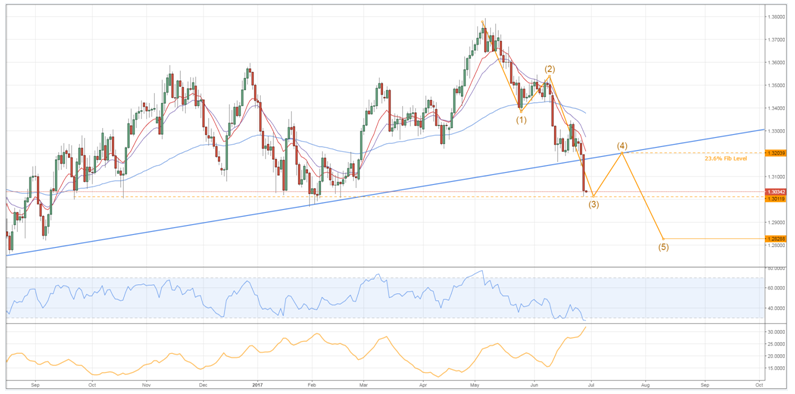Key Points:
- An Elliot wave is becoming apparent in the wake of the recent rout
- The breaking of the long-term trend line signals further losses are now likely
- A near-term recovery is still expected
The USD/CAD has been in free fall over the past few weeks in a move reminiscent of last year’s remarkable downtrend. Indeed, selling pressure has now broken through even the long-term trend line that formed as the pair sought to recover from last year’s collapse – a sign that downsides may have only just begun. However, before making a beeline for what could be a 10 month low, we may see a bit of buying pressure as a result of the overarching chart pattern.
Specifically, it is fast becoming clear that we may have an Elliot wave on our hands and that the most recent plunge lower represents the end of leg number 3. As a result, we would typically expect buying pressure to return shortly and a modest recovery to be seen. In this instance, such a move is made all the more likely by the sheer degree to which the pair has become oversold – as signalled by both the RSI and Stochastic oscillators – and the presence of a well-tested historical support level at 1.3011.

Nevertheless, this near-term bullish phase is likely to be short-lived and terminate at around the 1.3203 handle as the long-term bias remains highly bearish. More precisely, we forecast that the pair will move towards, and then rebound from, the old ascending trend line – due in no small part to numerous bearish technical indicators. In particular, the EMA bias and the Parabolic SAR readingsarelikely to be bearish even after the recovery. Moreover, the ADX will still be in strong trend territory if the upswing occurs in the forecasted time which could see added headwinds for the pair.
As for where we can expect the USD/CAD to plunge to, the 1.2828 mark looks like our next notable level of historic support. Indeed, this price has seen a number of reversals occur when it has been challenged – both immediately prior to, and in the wake of, last year’s massive upswing and subsequent downtrend. Furthermore, losses past this point will undermine the validity of the overall Elliot wave as it would make leg 5 longer than leg 3 which is typically a no-go.
Ultimately, we can’t ignore the impact of the fundamental side of things but, luckily, the fundamental bias is somewhat in favour of further downsides. This is largely due to the prevailing view that the USD’s ‘Trump Bump’ is all but doomed, a view that has been driven home this week by further failures in the GOP’s attempts at reforming healthcare. Nonetheless, watch out for any upsets that may come down the line – especially US rate hikes which could result in some volatility during the final leg of the Elliot wave.
